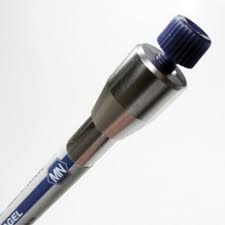


Sulfonated spherical PS/DVB resins in different ionic forms: mean particle size 10 µm, pore size 100 Å. Separation mechanism includes steric exclusion, ligand exchange and partition effects, ligand exchange being the predominant force, since the hydrated metal ions form strong interactions with the hydroxyl groups of the sample molecules. The intensity of these interactions decreases in the sequence Pb, Ca, Na.
NUCLEOGEL® Ion exchange chromatography columns for biological macromolecules.
Separation mechanism includes steric exclusion, ligand exchange and partition effects, ligand exchange being the predominant force, since the hydrated metal ions form strong interactions with the hydroxyl groups of the sample molecules. The intensity of these interactions decreases in the sequence Pb, Ca, Na.
NUCLEOGEL® SAX
Polymer-based HPLC phases for anion exchange chromatography of biological macromolecules
Features
NUCLEOGEL® SCX
Polymer-based HPLC phase for cation exchange chromatography of biological macromolecules
Features
NUCLEOGEL® SUGAR 810
Polymer-based HPLC phases for separation of sugars
Features
NUCLEOGEL® SUGAR and NUCLEOGEL® ION 300 OA
Polymer-based HPLC phases for separation of sugars
Features
NUCLEOGEL® ION 300 OA: H+ form for separation of sugars, alcohols and organic acids · USP L17
NUCLEOGEL® SUGAR Ca: separation of mono- and oligosaccharides, sugar alcohols · USP L19
NUCLEOGEL® SUGAR Pb: separation of mono- and disaccharides from food & biological samples · USP L34
NUCLEOGEL® SUGAR Na: separation of oligosaccharides from starch hydrolyzates and food · USP L58

